Nua Healthcare Placement: Gibb's Reflective Cycle Detailed Portfolio
VerifiedAdded on 2023/06/13
|25
|7851
|245
Portfolio
AI Summary
This portfolio documents a student's placement experience at The Meadows, a residential unit of Nua Healthcare Services, utilizing Gibb's Reflective Cycle. The portfolio details the aims and objectives of Nua Healthcare, which focuses on providing person-centered care to individuals with complex needs such as Autism Spectrum Disorder and intellectual disabilities. It addresses relevant legislation like the Health Act 2007 and the Disabilities Regulation 2013-2015, along with the application and effectiveness of organizational policies. A significant portion of the portfolio is dedicated to a specific intervention involving 1:1 protected conversation time for a service user with ASD, outlining the assessment of need using the KIT model, the intervention's implementation, evaluation, and the underpinning theories such as Baron-Cohen's work on autism and Biestek's relationship-based practice. The portfolio also reflects on the use of supervision and the importance of continuous professional development in social care practice.

Running head: GIBB’S REFLECTIVE CYCLE
Gibb’s Reflective Cycle
Name of Student
Name of University
Author Note
Gibb’s Reflective Cycle
Name of Student
Name of University
Author Note
Paraphrase This Document
Need a fresh take? Get an instant paraphrase of this document with our AI Paraphraser

1GIBB’S REFLECTIVE CYCLE
Part 1:
a) The aim and objectives of the service:
The Meadows is a medium support residential department of Nua Health Services and I finished
my placement at The Meadows. Nua Health care caters to the complex needs of children and
adults by providing wide range of service like community outreach service, day care service and
residential support services. It has a role in fulfilling complex needs of clients with mental
illnesses like dementia, intellectual disorder, autism, asperger syndrome, acute brain injury and
many other mental health issues.
The main purpose of the agency is to provide individualistic care to service users by means of
person centered care plan that fulfills individual needs as well as future needs of clients. Its goal
is also understood from its mission statement which states that ‘Nua Health Services believes in
supporting people to live a meaningful and personalized lifestyle’ (Nua Healthcare Services,
n.d.). The company’s interest in patient-centered care is also understood from the value of
dignity and respect, partnership, personalized and community support. Dignity and respect
implies fulfilling the unique needs of each individual. Partnership involves working in
collaboration with other service users. Personalized care involves giving freedom to client to
proceed at their own pace and the value of community implies encouraging users to contribute
for the welfare of the community.
B) Relevant legislation suitable for the agency
Since ‘The Meadows’ is a residential service that provides care to people children and adults
with disabilities, it must comply the Health Act 2007 legislation, the Disabilities Regulation
2013-2015 and fulfill the National Standards for Residential Services for Children and Adults
Part 1:
a) The aim and objectives of the service:
The Meadows is a medium support residential department of Nua Health Services and I finished
my placement at The Meadows. Nua Health care caters to the complex needs of children and
adults by providing wide range of service like community outreach service, day care service and
residential support services. It has a role in fulfilling complex needs of clients with mental
illnesses like dementia, intellectual disorder, autism, asperger syndrome, acute brain injury and
many other mental health issues.
The main purpose of the agency is to provide individualistic care to service users by means of
person centered care plan that fulfills individual needs as well as future needs of clients. Its goal
is also understood from its mission statement which states that ‘Nua Health Services believes in
supporting people to live a meaningful and personalized lifestyle’ (Nua Healthcare Services,
n.d.). The company’s interest in patient-centered care is also understood from the value of
dignity and respect, partnership, personalized and community support. Dignity and respect
implies fulfilling the unique needs of each individual. Partnership involves working in
collaboration with other service users. Personalized care involves giving freedom to client to
proceed at their own pace and the value of community implies encouraging users to contribute
for the welfare of the community.
B) Relevant legislation suitable for the agency
Since ‘The Meadows’ is a residential service that provides care to people children and adults
with disabilities, it must comply the Health Act 2007 legislation, the Disabilities Regulation
2013-2015 and fulfill the National Standards for Residential Services for Children and Adults
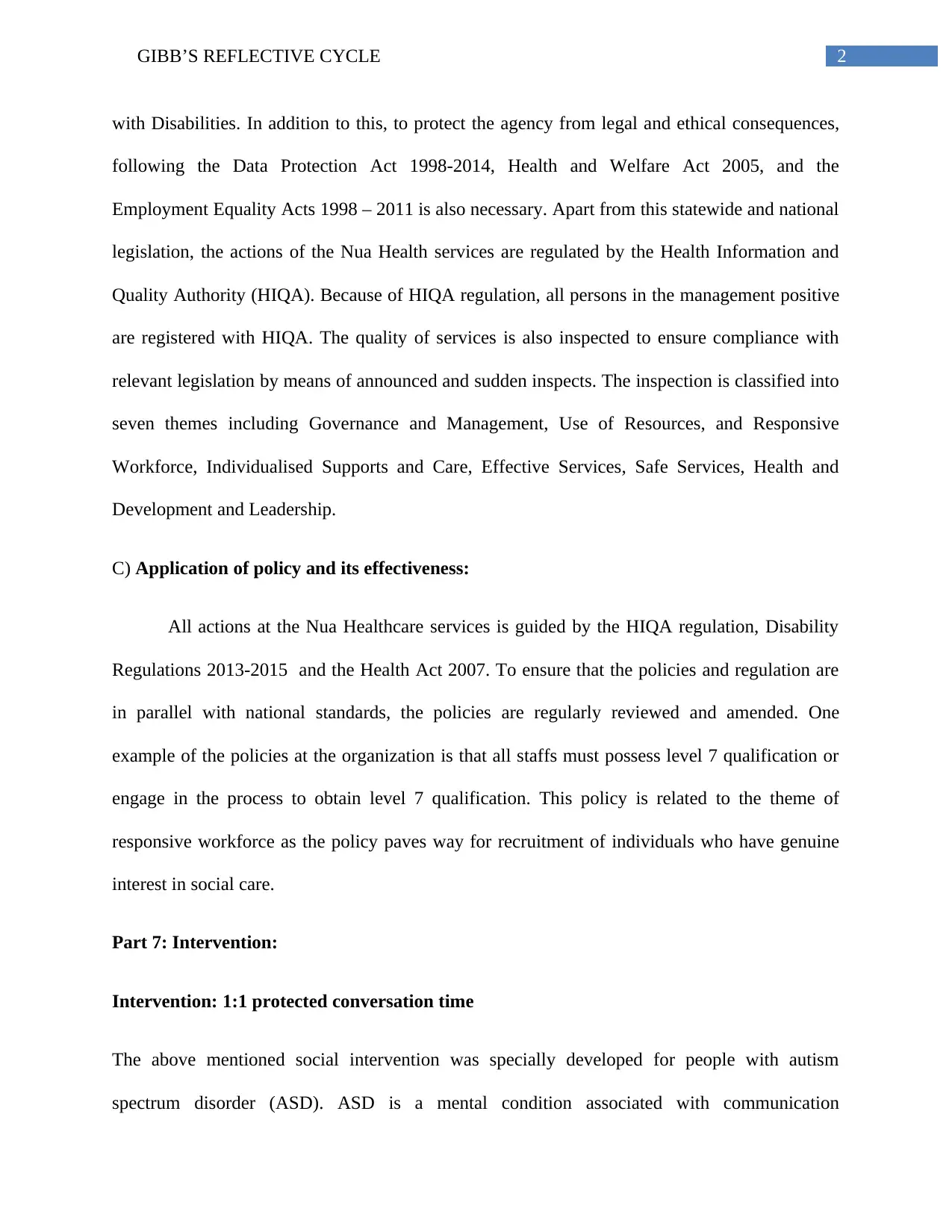
2GIBB’S REFLECTIVE CYCLE
with Disabilities. In addition to this, to protect the agency from legal and ethical consequences,
following the Data Protection Act 1998-2014, Health and Welfare Act 2005, and the
Employment Equality Acts 1998 – 2011 is also necessary. Apart from this statewide and national
legislation, the actions of the Nua Health services are regulated by the Health Information and
Quality Authority (HIQA). Because of HIQA regulation, all persons in the management positive
are registered with HIQA. The quality of services is also inspected to ensure compliance with
relevant legislation by means of announced and sudden inspects. The inspection is classified into
seven themes including Governance and Management, Use of Resources, and Responsive
Workforce, Individualised Supports and Care, Effective Services, Safe Services, Health and
Development and Leadership.
C) Application of policy and its effectiveness:
All actions at the Nua Healthcare services is guided by the HIQA regulation, Disability
Regulations 2013-2015 and the Health Act 2007. To ensure that the policies and regulation are
in parallel with national standards, the policies are regularly reviewed and amended. One
example of the policies at the organization is that all staffs must possess level 7 qualification or
engage in the process to obtain level 7 qualification. This policy is related to the theme of
responsive workforce as the policy paves way for recruitment of individuals who have genuine
interest in social care.
Part 7: Intervention:
Intervention: 1:1 protected conversation time
The above mentioned social intervention was specially developed for people with autism
spectrum disorder (ASD). ASD is a mental condition associated with communication
with Disabilities. In addition to this, to protect the agency from legal and ethical consequences,
following the Data Protection Act 1998-2014, Health and Welfare Act 2005, and the
Employment Equality Acts 1998 – 2011 is also necessary. Apart from this statewide and national
legislation, the actions of the Nua Health services are regulated by the Health Information and
Quality Authority (HIQA). Because of HIQA regulation, all persons in the management positive
are registered with HIQA. The quality of services is also inspected to ensure compliance with
relevant legislation by means of announced and sudden inspects. The inspection is classified into
seven themes including Governance and Management, Use of Resources, and Responsive
Workforce, Individualised Supports and Care, Effective Services, Safe Services, Health and
Development and Leadership.
C) Application of policy and its effectiveness:
All actions at the Nua Healthcare services is guided by the HIQA regulation, Disability
Regulations 2013-2015 and the Health Act 2007. To ensure that the policies and regulation are
in parallel with national standards, the policies are regularly reviewed and amended. One
example of the policies at the organization is that all staffs must possess level 7 qualification or
engage in the process to obtain level 7 qualification. This policy is related to the theme of
responsive workforce as the policy paves way for recruitment of individuals who have genuine
interest in social care.
Part 7: Intervention:
Intervention: 1:1 protected conversation time
The above mentioned social intervention was specially developed for people with autism
spectrum disorder (ASD). ASD is a mental condition associated with communication
⊘ This is a preview!⊘
Do you want full access?
Subscribe today to unlock all pages.

Trusted by 1+ million students worldwide

3GIBB’S REFLECTIVE CYCLE
impairment, poor social functioning and aggressive and self-destructive behaviour in an
individual (Altiere & von Kluge, 2008, p. 83). Similar symptoms were also found in the service
user for whom I applied the intervention. The review of client history revealed he avoided
conversation although he could interact with people. He did not display his emotions very often,
however this suppression of emotion resulted in sudden outburst of anger. In such situation,
patient was exhibit aggressive and assaultive behaviour. He also had low self-esteem and was
reluctant to talk with unfamiliar people. I decided to use the 1:1 protected conversation time
intervention for the service used after consulting my supervisor because it will facilitate
development of interpersonal skill in client and address feelings of worthlessness too.
Assessment of need
The common diagnostic features found in patient with Asperger syndrome and ASD are poor
social development, difficulty in development of communication and presence of strong and
repetitive behaviour (Baron-Cohen 2008). Similar features were also found in the client as the
patient came with poor interpersonal skills, need for reassurance and difficulty in beginning a
conversation. To apply the KIT model, the profiled of the service used was developed first
(Collingwood, 2005). The profile of the client are as follows:
The client is a 26 year old Romanian male with keen interest in music. He was adopted in
childhood and lives with his sister, however he has poor family relationship. The service user is
low in self-esteem and struggles to control his emotion. This often results in a crisis situation.
However, the positive aspects of his profile is that he has good sense of humour and high level of
intelligence. He wears bright coloured clothes and he is found to be hypochondriac as he get
anxious even for a very minor issues. The client has also revealed that whenever he get to know
impairment, poor social functioning and aggressive and self-destructive behaviour in an
individual (Altiere & von Kluge, 2008, p. 83). Similar symptoms were also found in the service
user for whom I applied the intervention. The review of client history revealed he avoided
conversation although he could interact with people. He did not display his emotions very often,
however this suppression of emotion resulted in sudden outburst of anger. In such situation,
patient was exhibit aggressive and assaultive behaviour. He also had low self-esteem and was
reluctant to talk with unfamiliar people. I decided to use the 1:1 protected conversation time
intervention for the service used after consulting my supervisor because it will facilitate
development of interpersonal skill in client and address feelings of worthlessness too.
Assessment of need
The common diagnostic features found in patient with Asperger syndrome and ASD are poor
social development, difficulty in development of communication and presence of strong and
repetitive behaviour (Baron-Cohen 2008). Similar features were also found in the client as the
patient came with poor interpersonal skills, need for reassurance and difficulty in beginning a
conversation. To apply the KIT model, the profiled of the service used was developed first
(Collingwood, 2005). The profile of the client are as follows:
The client is a 26 year old Romanian male with keen interest in music. He was adopted in
childhood and lives with his sister, however he has poor family relationship. The service user is
low in self-esteem and struggles to control his emotion. This often results in a crisis situation.
However, the positive aspects of his profile is that he has good sense of humour and high level of
intelligence. He wears bright coloured clothes and he is found to be hypochondriac as he get
anxious even for a very minor issues. The client has also revealed that whenever he get to know
Paraphrase This Document
Need a fresh take? Get an instant paraphrase of this document with our AI Paraphraser
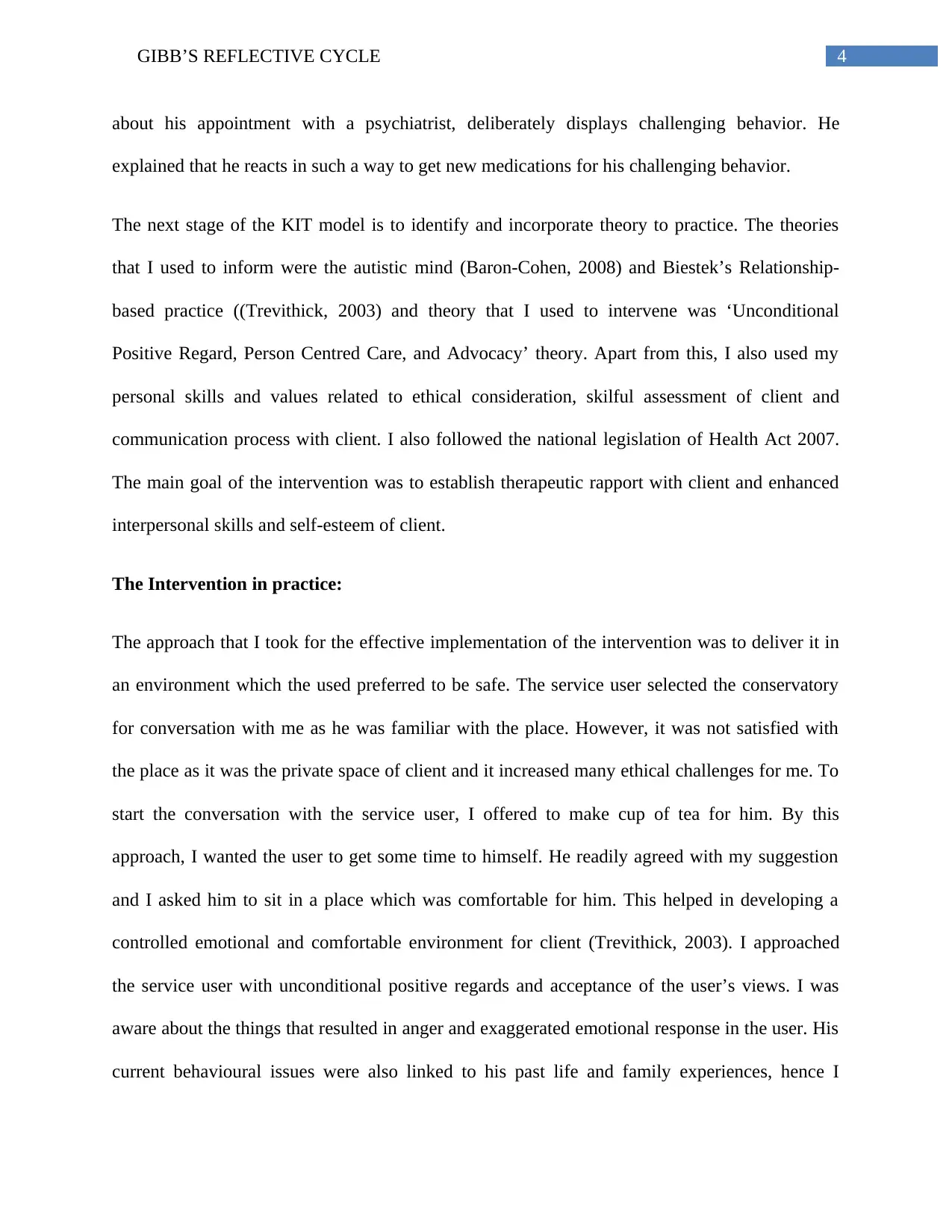
4GIBB’S REFLECTIVE CYCLE
about his appointment with a psychiatrist, deliberately displays challenging behavior. He
explained that he reacts in such a way to get new medications for his challenging behavior.
The next stage of the KIT model is to identify and incorporate theory to practice. The theories
that I used to inform were the autistic mind (Baron-Cohen, 2008) and Biestek’s Relationship-
based practice ((Trevithick, 2003) and theory that I used to intervene was ‘Unconditional
Positive Regard, Person Centred Care, and Advocacy’ theory. Apart from this, I also used my
personal skills and values related to ethical consideration, skilful assessment of client and
communication process with client. I also followed the national legislation of Health Act 2007.
The main goal of the intervention was to establish therapeutic rapport with client and enhanced
interpersonal skills and self-esteem of client.
The Intervention in practice:
The approach that I took for the effective implementation of the intervention was to deliver it in
an environment which the used preferred to be safe. The service user selected the conservatory
for conversation with me as he was familiar with the place. However, it was not satisfied with
the place as it was the private space of client and it increased many ethical challenges for me. To
start the conversation with the service user, I offered to make cup of tea for him. By this
approach, I wanted the user to get some time to himself. He readily agreed with my suggestion
and I asked him to sit in a place which was comfortable for him. This helped in developing a
controlled emotional and comfortable environment for client (Trevithick, 2003). I approached
the service user with unconditional positive regards and acceptance of the user’s views. I was
aware about the things that resulted in anger and exaggerated emotional response in the user. His
current behavioural issues were also linked to his past life and family experiences, hence I
about his appointment with a psychiatrist, deliberately displays challenging behavior. He
explained that he reacts in such a way to get new medications for his challenging behavior.
The next stage of the KIT model is to identify and incorporate theory to practice. The theories
that I used to inform were the autistic mind (Baron-Cohen, 2008) and Biestek’s Relationship-
based practice ((Trevithick, 2003) and theory that I used to intervene was ‘Unconditional
Positive Regard, Person Centred Care, and Advocacy’ theory. Apart from this, I also used my
personal skills and values related to ethical consideration, skilful assessment of client and
communication process with client. I also followed the national legislation of Health Act 2007.
The main goal of the intervention was to establish therapeutic rapport with client and enhanced
interpersonal skills and self-esteem of client.
The Intervention in practice:
The approach that I took for the effective implementation of the intervention was to deliver it in
an environment which the used preferred to be safe. The service user selected the conservatory
for conversation with me as he was familiar with the place. However, it was not satisfied with
the place as it was the private space of client and it increased many ethical challenges for me. To
start the conversation with the service user, I offered to make cup of tea for him. By this
approach, I wanted the user to get some time to himself. He readily agreed with my suggestion
and I asked him to sit in a place which was comfortable for him. This helped in developing a
controlled emotional and comfortable environment for client (Trevithick, 2003). I approached
the service user with unconditional positive regards and acceptance of the user’s views. I was
aware about the things that resulted in anger and exaggerated emotional response in the user. His
current behavioural issues were also linked to his past life and family experiences, hence I
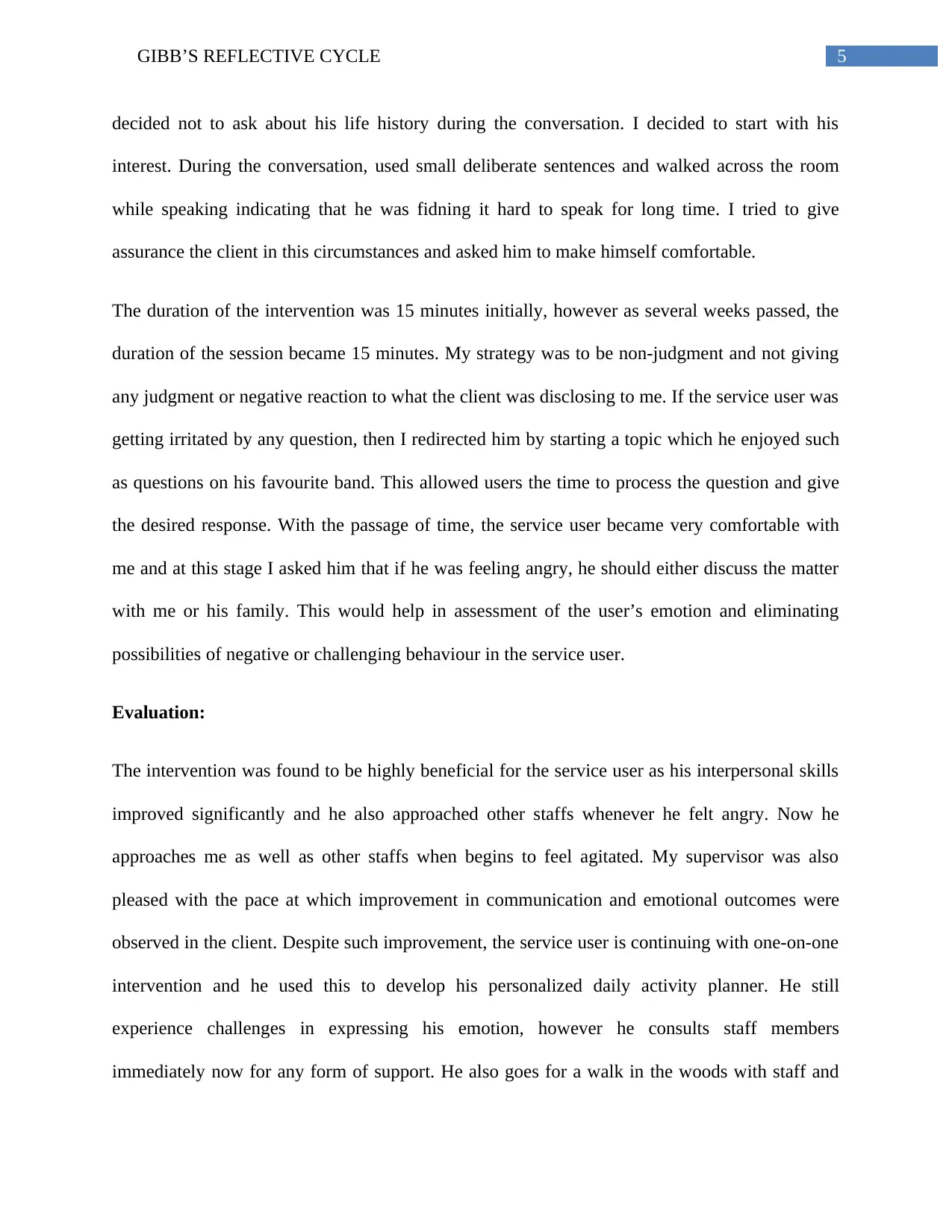
5GIBB’S REFLECTIVE CYCLE
decided not to ask about his life history during the conversation. I decided to start with his
interest. During the conversation, used small deliberate sentences and walked across the room
while speaking indicating that he was fidning it hard to speak for long time. I tried to give
assurance the client in this circumstances and asked him to make himself comfortable.
The duration of the intervention was 15 minutes initially, however as several weeks passed, the
duration of the session became 15 minutes. My strategy was to be non-judgment and not giving
any judgment or negative reaction to what the client was disclosing to me. If the service user was
getting irritated by any question, then I redirected him by starting a topic which he enjoyed such
as questions on his favourite band. This allowed users the time to process the question and give
the desired response. With the passage of time, the service user became very comfortable with
me and at this stage I asked him that if he was feeling angry, he should either discuss the matter
with me or his family. This would help in assessment of the user’s emotion and eliminating
possibilities of negative or challenging behaviour in the service user.
Evaluation:
The intervention was found to be highly beneficial for the service user as his interpersonal skills
improved significantly and he also approached other staffs whenever he felt angry. Now he
approaches me as well as other staffs when begins to feel agitated. My supervisor was also
pleased with the pace at which improvement in communication and emotional outcomes were
observed in the client. Despite such improvement, the service user is continuing with one-on-one
intervention and he used this to develop his personalized daily activity planner. He still
experience challenges in expressing his emotion, however he consults staff members
immediately now for any form of support. He also goes for a walk in the woods with staff and
decided not to ask about his life history during the conversation. I decided to start with his
interest. During the conversation, used small deliberate sentences and walked across the room
while speaking indicating that he was fidning it hard to speak for long time. I tried to give
assurance the client in this circumstances and asked him to make himself comfortable.
The duration of the intervention was 15 minutes initially, however as several weeks passed, the
duration of the session became 15 minutes. My strategy was to be non-judgment and not giving
any judgment or negative reaction to what the client was disclosing to me. If the service user was
getting irritated by any question, then I redirected him by starting a topic which he enjoyed such
as questions on his favourite band. This allowed users the time to process the question and give
the desired response. With the passage of time, the service user became very comfortable with
me and at this stage I asked him that if he was feeling angry, he should either discuss the matter
with me or his family. This would help in assessment of the user’s emotion and eliminating
possibilities of negative or challenging behaviour in the service user.
Evaluation:
The intervention was found to be highly beneficial for the service user as his interpersonal skills
improved significantly and he also approached other staffs whenever he felt angry. Now he
approaches me as well as other staffs when begins to feel agitated. My supervisor was also
pleased with the pace at which improvement in communication and emotional outcomes were
observed in the client. Despite such improvement, the service user is continuing with one-on-one
intervention and he used this to develop his personalized daily activity planner. He still
experience challenges in expressing his emotion, however he consults staff members
immediately now for any form of support. He also goes for a walk in the woods with staff and
⊘ This is a preview!⊘
Do you want full access?
Subscribe today to unlock all pages.

Trusted by 1+ million students worldwide
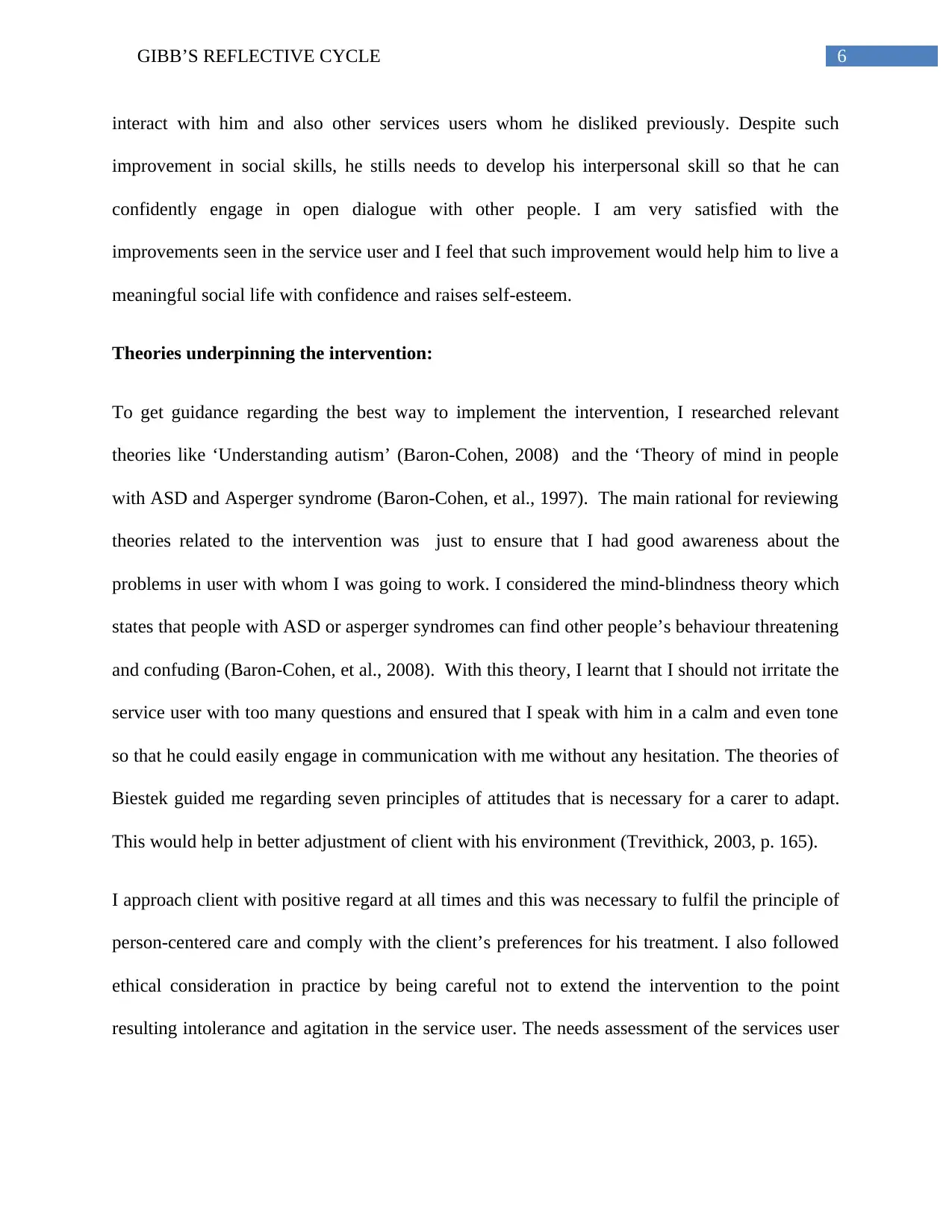
6GIBB’S REFLECTIVE CYCLE
interact with him and also other services users whom he disliked previously. Despite such
improvement in social skills, he stills needs to develop his interpersonal skill so that he can
confidently engage in open dialogue with other people. I am very satisfied with the
improvements seen in the service user and I feel that such improvement would help him to live a
meaningful social life with confidence and raises self-esteem.
Theories underpinning the intervention:
To get guidance regarding the best way to implement the intervention, I researched relevant
theories like ‘Understanding autism’ (Baron-Cohen, 2008) and the ‘Theory of mind in people
with ASD and Asperger syndrome (Baron-Cohen, et al., 1997). The main rational for reviewing
theories related to the intervention was just to ensure that I had good awareness about the
problems in user with whom I was going to work. I considered the mind-blindness theory which
states that people with ASD or asperger syndromes can find other people’s behaviour threatening
and confuding (Baron-Cohen, et al., 2008). With this theory, I learnt that I should not irritate the
service user with too many questions and ensured that I speak with him in a calm and even tone
so that he could easily engage in communication with me without any hesitation. The theories of
Biestek guided me regarding seven principles of attitudes that is necessary for a carer to adapt.
This would help in better adjustment of client with his environment (Trevithick, 2003, p. 165).
I approach client with positive regard at all times and this was necessary to fulfil the principle of
person-centered care and comply with the client’s preferences for his treatment. I also followed
ethical consideration in practice by being careful not to extend the intervention to the point
resulting intolerance and agitation in the service user. The needs assessment of the services user
interact with him and also other services users whom he disliked previously. Despite such
improvement in social skills, he stills needs to develop his interpersonal skill so that he can
confidently engage in open dialogue with other people. I am very satisfied with the
improvements seen in the service user and I feel that such improvement would help him to live a
meaningful social life with confidence and raises self-esteem.
Theories underpinning the intervention:
To get guidance regarding the best way to implement the intervention, I researched relevant
theories like ‘Understanding autism’ (Baron-Cohen, 2008) and the ‘Theory of mind in people
with ASD and Asperger syndrome (Baron-Cohen, et al., 1997). The main rational for reviewing
theories related to the intervention was just to ensure that I had good awareness about the
problems in user with whom I was going to work. I considered the mind-blindness theory which
states that people with ASD or asperger syndromes can find other people’s behaviour threatening
and confuding (Baron-Cohen, et al., 2008). With this theory, I learnt that I should not irritate the
service user with too many questions and ensured that I speak with him in a calm and even tone
so that he could easily engage in communication with me without any hesitation. The theories of
Biestek guided me regarding seven principles of attitudes that is necessary for a carer to adapt.
This would help in better adjustment of client with his environment (Trevithick, 2003, p. 165).
I approach client with positive regard at all times and this was necessary to fulfil the principle of
person-centered care and comply with the client’s preferences for his treatment. I also followed
ethical consideration in practice by being careful not to extend the intervention to the point
resulting intolerance and agitation in the service user. The needs assessment of the services user
Paraphrase This Document
Need a fresh take? Get an instant paraphrase of this document with our AI Paraphraser
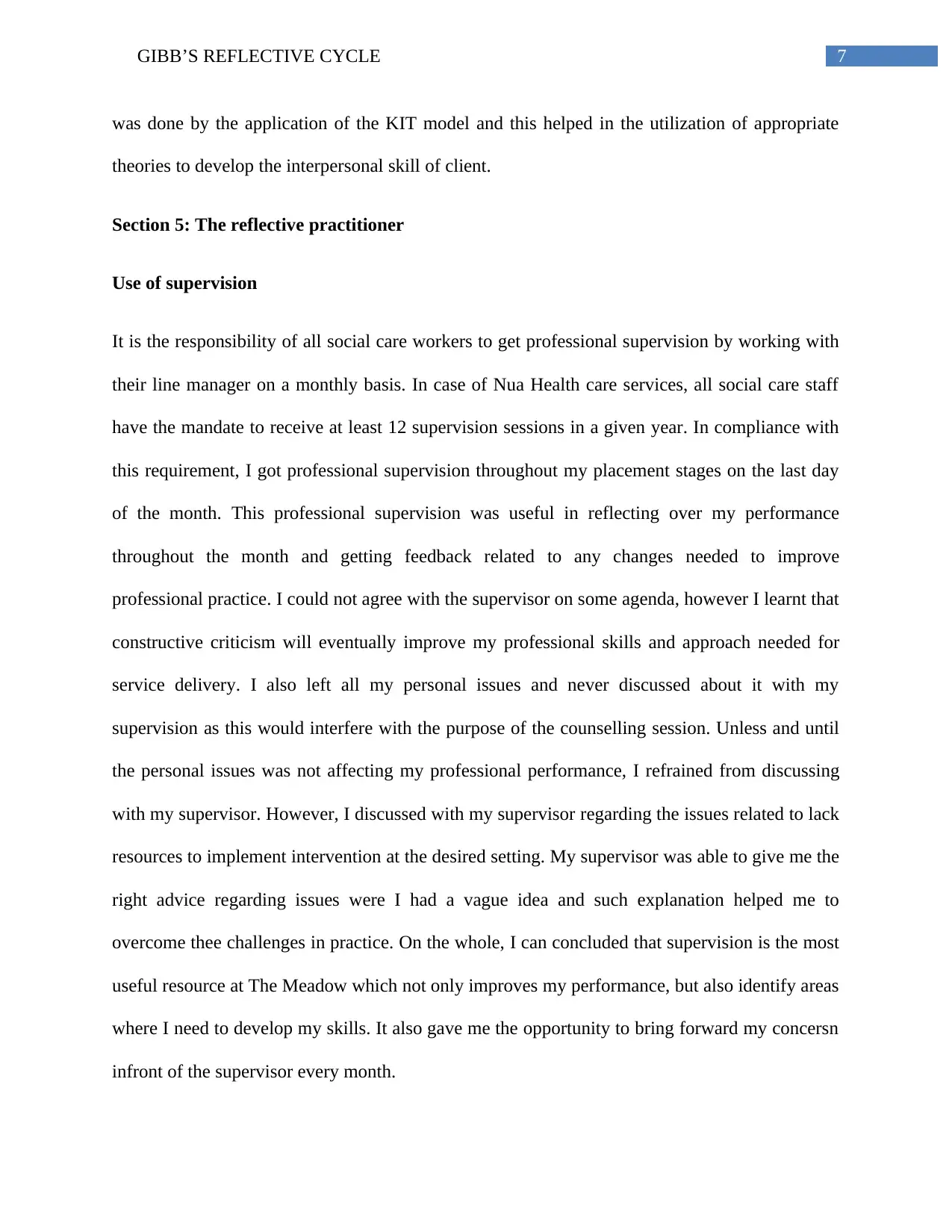
7GIBB’S REFLECTIVE CYCLE
was done by the application of the KIT model and this helped in the utilization of appropriate
theories to develop the interpersonal skill of client.
Section 5: The reflective practitioner
Use of supervision
It is the responsibility of all social care workers to get professional supervision by working with
their line manager on a monthly basis. In case of Nua Health care services, all social care staff
have the mandate to receive at least 12 supervision sessions in a given year. In compliance with
this requirement, I got professional supervision throughout my placement stages on the last day
of the month. This professional supervision was useful in reflecting over my performance
throughout the month and getting feedback related to any changes needed to improve
professional practice. I could not agree with the supervisor on some agenda, however I learnt that
constructive criticism will eventually improve my professional skills and approach needed for
service delivery. I also left all my personal issues and never discussed about it with my
supervision as this would interfere with the purpose of the counselling session. Unless and until
the personal issues was not affecting my professional performance, I refrained from discussing
with my supervisor. However, I discussed with my supervisor regarding the issues related to lack
resources to implement intervention at the desired setting. My supervisor was able to give me the
right advice regarding issues were I had a vague idea and such explanation helped me to
overcome thee challenges in practice. On the whole, I can concluded that supervision is the most
useful resource at The Meadow which not only improves my performance, but also identify areas
where I need to develop my skills. It also gave me the opportunity to bring forward my concersn
infront of the supervisor every month.
was done by the application of the KIT model and this helped in the utilization of appropriate
theories to develop the interpersonal skill of client.
Section 5: The reflective practitioner
Use of supervision
It is the responsibility of all social care workers to get professional supervision by working with
their line manager on a monthly basis. In case of Nua Health care services, all social care staff
have the mandate to receive at least 12 supervision sessions in a given year. In compliance with
this requirement, I got professional supervision throughout my placement stages on the last day
of the month. This professional supervision was useful in reflecting over my performance
throughout the month and getting feedback related to any changes needed to improve
professional practice. I could not agree with the supervisor on some agenda, however I learnt that
constructive criticism will eventually improve my professional skills and approach needed for
service delivery. I also left all my personal issues and never discussed about it with my
supervision as this would interfere with the purpose of the counselling session. Unless and until
the personal issues was not affecting my professional performance, I refrained from discussing
with my supervisor. However, I discussed with my supervisor regarding the issues related to lack
resources to implement intervention at the desired setting. My supervisor was able to give me the
right advice regarding issues were I had a vague idea and such explanation helped me to
overcome thee challenges in practice. On the whole, I can concluded that supervision is the most
useful resource at The Meadow which not only improves my performance, but also identify areas
where I need to develop my skills. It also gave me the opportunity to bring forward my concersn
infront of the supervisor every month.
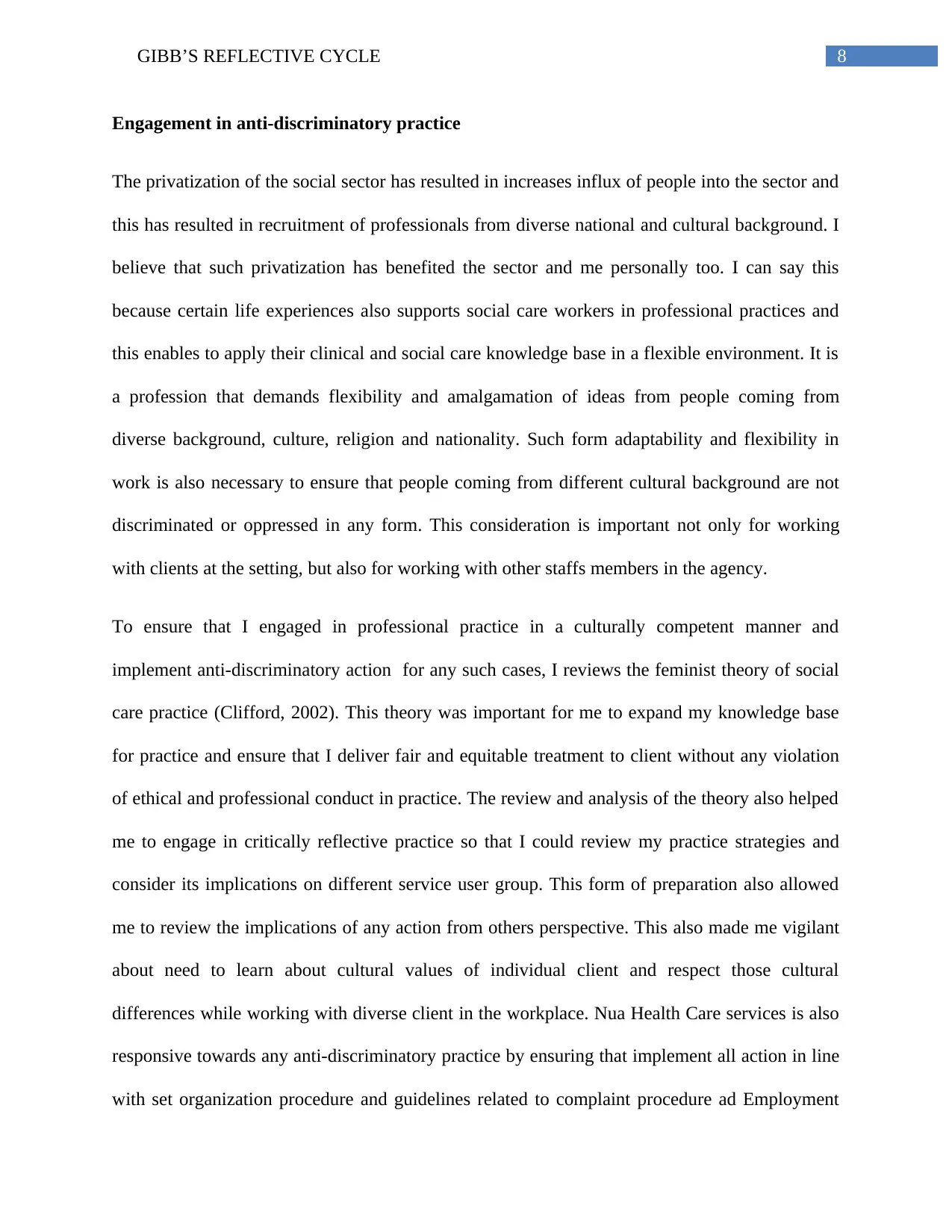
8GIBB’S REFLECTIVE CYCLE
Engagement in anti-discriminatory practice
The privatization of the social sector has resulted in increases influx of people into the sector and
this has resulted in recruitment of professionals from diverse national and cultural background. I
believe that such privatization has benefited the sector and me personally too. I can say this
because certain life experiences also supports social care workers in professional practices and
this enables to apply their clinical and social care knowledge base in a flexible environment. It is
a profession that demands flexibility and amalgamation of ideas from people coming from
diverse background, culture, religion and nationality. Such form adaptability and flexibility in
work is also necessary to ensure that people coming from different cultural background are not
discriminated or oppressed in any form. This consideration is important not only for working
with clients at the setting, but also for working with other staffs members in the agency.
To ensure that I engaged in professional practice in a culturally competent manner and
implement anti-discriminatory action for any such cases, I reviews the feminist theory of social
care practice (Clifford, 2002). This theory was important for me to expand my knowledge base
for practice and ensure that I deliver fair and equitable treatment to client without any violation
of ethical and professional conduct in practice. The review and analysis of the theory also helped
me to engage in critically reflective practice so that I could review my practice strategies and
consider its implications on different service user group. This form of preparation also allowed
me to review the implications of any action from others perspective. This also made me vigilant
about need to learn about cultural values of individual client and respect those cultural
differences while working with diverse client in the workplace. Nua Health Care services is also
responsive towards any anti-discriminatory practice by ensuring that implement all action in line
with set organization procedure and guidelines related to complaint procedure ad Employment
Engagement in anti-discriminatory practice
The privatization of the social sector has resulted in increases influx of people into the sector and
this has resulted in recruitment of professionals from diverse national and cultural background. I
believe that such privatization has benefited the sector and me personally too. I can say this
because certain life experiences also supports social care workers in professional practices and
this enables to apply their clinical and social care knowledge base in a flexible environment. It is
a profession that demands flexibility and amalgamation of ideas from people coming from
diverse background, culture, religion and nationality. Such form adaptability and flexibility in
work is also necessary to ensure that people coming from different cultural background are not
discriminated or oppressed in any form. This consideration is important not only for working
with clients at the setting, but also for working with other staffs members in the agency.
To ensure that I engaged in professional practice in a culturally competent manner and
implement anti-discriminatory action for any such cases, I reviews the feminist theory of social
care practice (Clifford, 2002). This theory was important for me to expand my knowledge base
for practice and ensure that I deliver fair and equitable treatment to client without any violation
of ethical and professional conduct in practice. The review and analysis of the theory also helped
me to engage in critically reflective practice so that I could review my practice strategies and
consider its implications on different service user group. This form of preparation also allowed
me to review the implications of any action from others perspective. This also made me vigilant
about need to learn about cultural values of individual client and respect those cultural
differences while working with diverse client in the workplace. Nua Health Care services is also
responsive towards any anti-discriminatory practice by ensuring that implement all action in line
with set organization procedure and guidelines related to complaint procedure ad Employment
⊘ This is a preview!⊘
Do you want full access?
Subscribe today to unlock all pages.

Trusted by 1+ million students worldwide
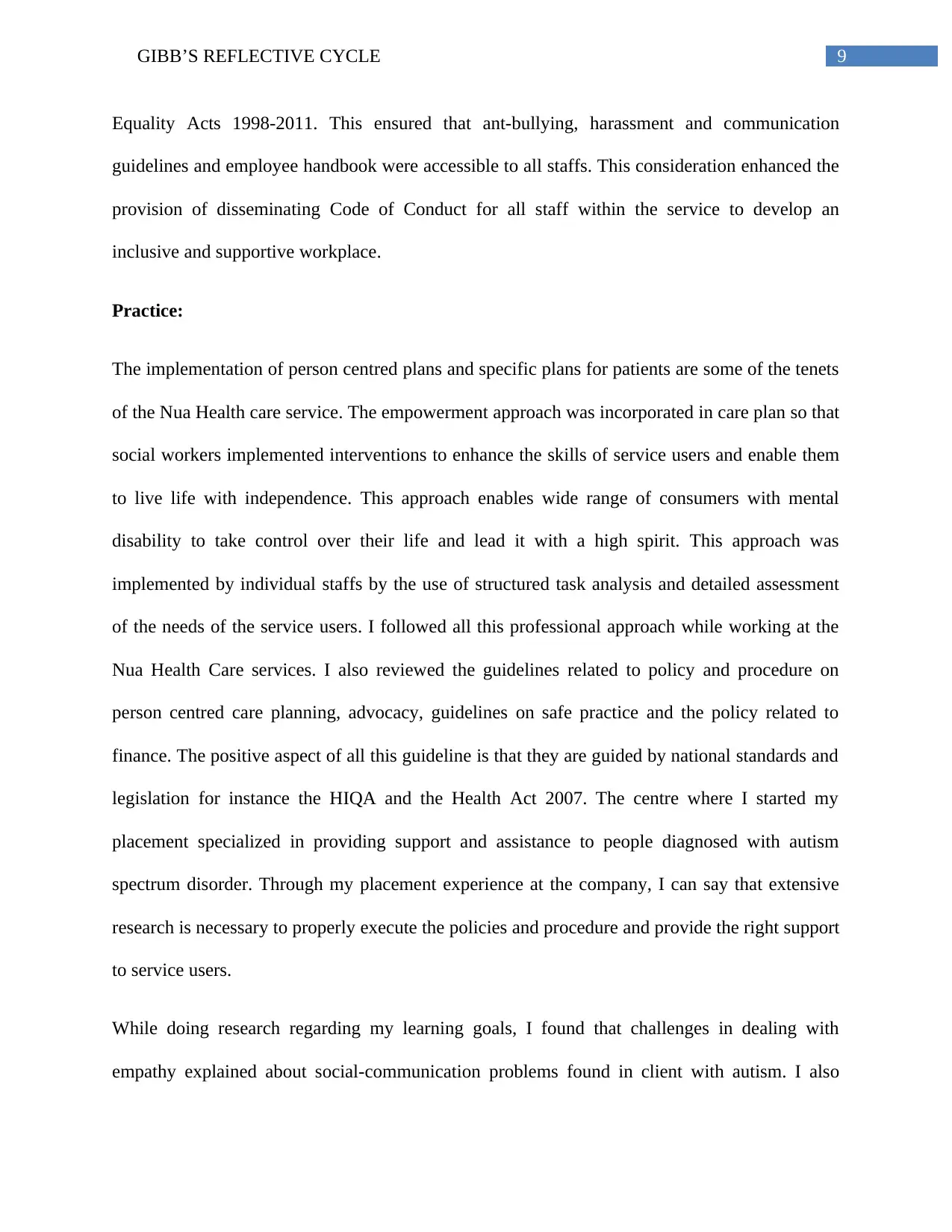
9GIBB’S REFLECTIVE CYCLE
Equality Acts 1998-2011. This ensured that ant-bullying, harassment and communication
guidelines and employee handbook were accessible to all staffs. This consideration enhanced the
provision of disseminating Code of Conduct for all staff within the service to develop an
inclusive and supportive workplace.
Practice:
The implementation of person centred plans and specific plans for patients are some of the tenets
of the Nua Health care service. The empowerment approach was incorporated in care plan so that
social workers implemented interventions to enhance the skills of service users and enable them
to live life with independence. This approach enables wide range of consumers with mental
disability to take control over their life and lead it with a high spirit. This approach was
implemented by individual staffs by the use of structured task analysis and detailed assessment
of the needs of the service users. I followed all this professional approach while working at the
Nua Health Care services. I also reviewed the guidelines related to policy and procedure on
person centred care planning, advocacy, guidelines on safe practice and the policy related to
finance. The positive aspect of all this guideline is that they are guided by national standards and
legislation for instance the HIQA and the Health Act 2007. The centre where I started my
placement specialized in providing support and assistance to people diagnosed with autism
spectrum disorder. Through my placement experience at the company, I can say that extensive
research is necessary to properly execute the policies and procedure and provide the right support
to service users.
While doing research regarding my learning goals, I found that challenges in dealing with
empathy explained about social-communication problems found in client with autism. I also
Equality Acts 1998-2011. This ensured that ant-bullying, harassment and communication
guidelines and employee handbook were accessible to all staffs. This consideration enhanced the
provision of disseminating Code of Conduct for all staff within the service to develop an
inclusive and supportive workplace.
Practice:
The implementation of person centred plans and specific plans for patients are some of the tenets
of the Nua Health care service. The empowerment approach was incorporated in care plan so that
social workers implemented interventions to enhance the skills of service users and enable them
to live life with independence. This approach enables wide range of consumers with mental
disability to take control over their life and lead it with a high spirit. This approach was
implemented by individual staffs by the use of structured task analysis and detailed assessment
of the needs of the service users. I followed all this professional approach while working at the
Nua Health Care services. I also reviewed the guidelines related to policy and procedure on
person centred care planning, advocacy, guidelines on safe practice and the policy related to
finance. The positive aspect of all this guideline is that they are guided by national standards and
legislation for instance the HIQA and the Health Act 2007. The centre where I started my
placement specialized in providing support and assistance to people diagnosed with autism
spectrum disorder. Through my placement experience at the company, I can say that extensive
research is necessary to properly execute the policies and procedure and provide the right support
to service users.
While doing research regarding my learning goals, I found that challenges in dealing with
empathy explained about social-communication problems found in client with autism. I also
Paraphrase This Document
Need a fresh take? Get an instant paraphrase of this document with our AI Paraphraser
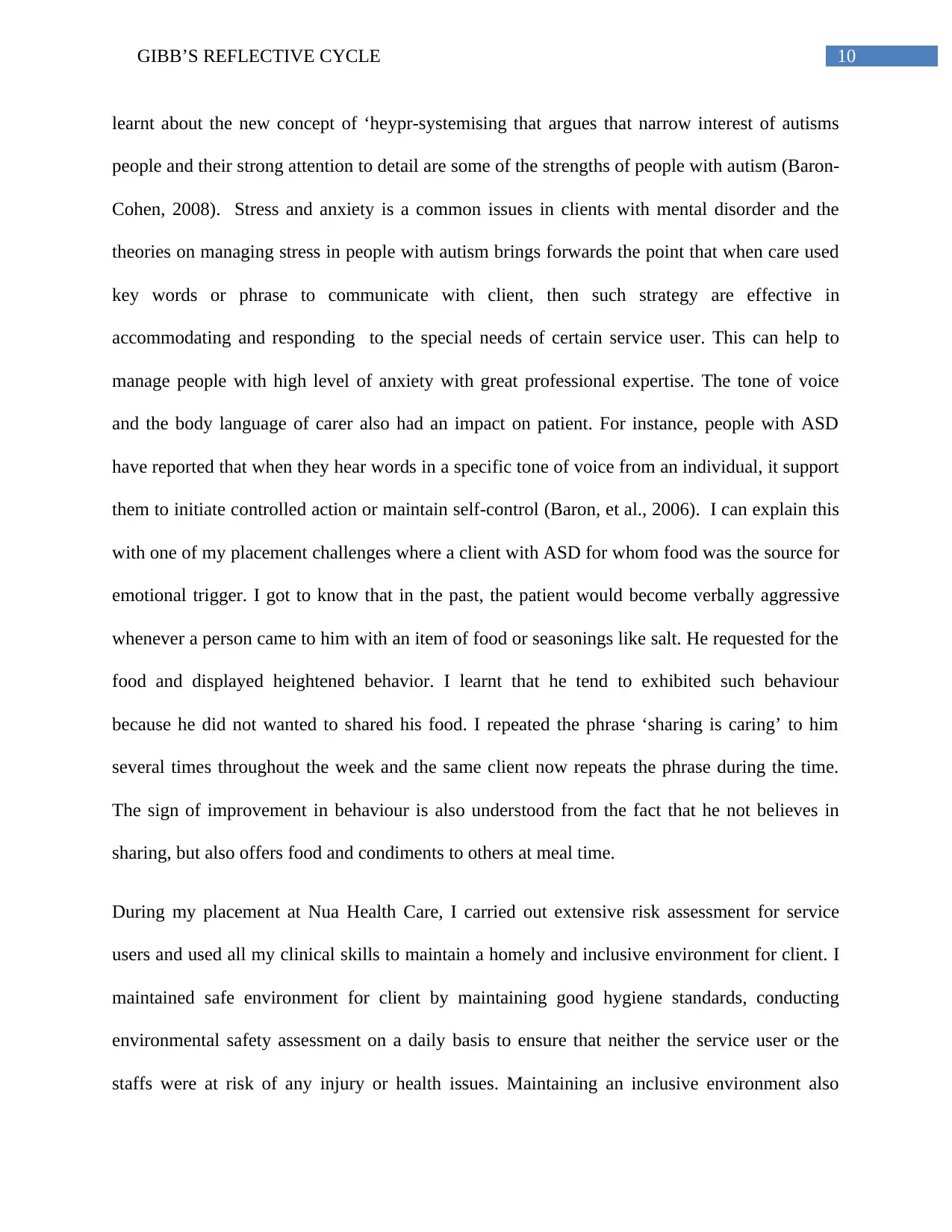
10GIBB’S REFLECTIVE CYCLE
learnt about the new concept of ‘heypr-systemising that argues that narrow interest of autisms
people and their strong attention to detail are some of the strengths of people with autism (Baron-
Cohen, 2008). Stress and anxiety is a common issues in clients with mental disorder and the
theories on managing stress in people with autism brings forwards the point that when care used
key words or phrase to communicate with client, then such strategy are effective in
accommodating and responding to the special needs of certain service user. This can help to
manage people with high level of anxiety with great professional expertise. The tone of voice
and the body language of carer also had an impact on patient. For instance, people with ASD
have reported that when they hear words in a specific tone of voice from an individual, it support
them to initiate controlled action or maintain self-control (Baron, et al., 2006). I can explain this
with one of my placement challenges where a client with ASD for whom food was the source for
emotional trigger. I got to know that in the past, the patient would become verbally aggressive
whenever a person came to him with an item of food or seasonings like salt. He requested for the
food and displayed heightened behavior. I learnt that he tend to exhibited such behaviour
because he did not wanted to shared his food. I repeated the phrase ‘sharing is caring’ to him
several times throughout the week and the same client now repeats the phrase during the time.
The sign of improvement in behaviour is also understood from the fact that he not believes in
sharing, but also offers food and condiments to others at meal time.
During my placement at Nua Health Care, I carried out extensive risk assessment for service
users and used all my clinical skills to maintain a homely and inclusive environment for client. I
maintained safe environment for client by maintaining good hygiene standards, conducting
environmental safety assessment on a daily basis to ensure that neither the service user or the
staffs were at risk of any injury or health issues. Maintaining an inclusive environment also
learnt about the new concept of ‘heypr-systemising that argues that narrow interest of autisms
people and their strong attention to detail are some of the strengths of people with autism (Baron-
Cohen, 2008). Stress and anxiety is a common issues in clients with mental disorder and the
theories on managing stress in people with autism brings forwards the point that when care used
key words or phrase to communicate with client, then such strategy are effective in
accommodating and responding to the special needs of certain service user. This can help to
manage people with high level of anxiety with great professional expertise. The tone of voice
and the body language of carer also had an impact on patient. For instance, people with ASD
have reported that when they hear words in a specific tone of voice from an individual, it support
them to initiate controlled action or maintain self-control (Baron, et al., 2006). I can explain this
with one of my placement challenges where a client with ASD for whom food was the source for
emotional trigger. I got to know that in the past, the patient would become verbally aggressive
whenever a person came to him with an item of food or seasonings like salt. He requested for the
food and displayed heightened behavior. I learnt that he tend to exhibited such behaviour
because he did not wanted to shared his food. I repeated the phrase ‘sharing is caring’ to him
several times throughout the week and the same client now repeats the phrase during the time.
The sign of improvement in behaviour is also understood from the fact that he not believes in
sharing, but also offers food and condiments to others at meal time.
During my placement at Nua Health Care, I carried out extensive risk assessment for service
users and used all my clinical skills to maintain a homely and inclusive environment for client. I
maintained safe environment for client by maintaining good hygiene standards, conducting
environmental safety assessment on a daily basis to ensure that neither the service user or the
staffs were at risk of any injury or health issues. Maintaining an inclusive environment also
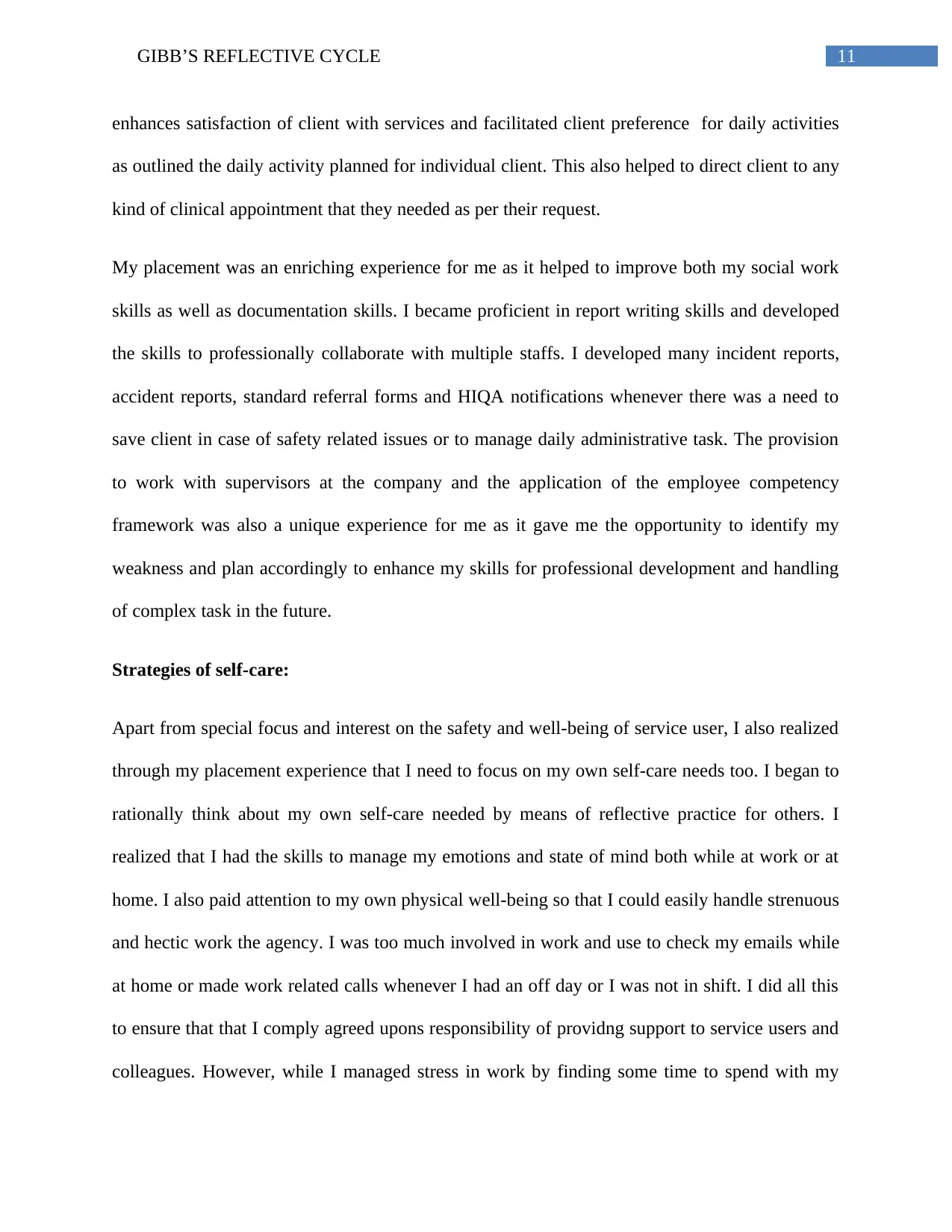
11GIBB’S REFLECTIVE CYCLE
enhances satisfaction of client with services and facilitated client preference for daily activities
as outlined the daily activity planned for individual client. This also helped to direct client to any
kind of clinical appointment that they needed as per their request.
My placement was an enriching experience for me as it helped to improve both my social work
skills as well as documentation skills. I became proficient in report writing skills and developed
the skills to professionally collaborate with multiple staffs. I developed many incident reports,
accident reports, standard referral forms and HIQA notifications whenever there was a need to
save client in case of safety related issues or to manage daily administrative task. The provision
to work with supervisors at the company and the application of the employee competency
framework was also a unique experience for me as it gave me the opportunity to identify my
weakness and plan accordingly to enhance my skills for professional development and handling
of complex task in the future.
Strategies of self-care:
Apart from special focus and interest on the safety and well-being of service user, I also realized
through my placement experience that I need to focus on my own self-care needs too. I began to
rationally think about my own self-care needed by means of reflective practice for others. I
realized that I had the skills to manage my emotions and state of mind both while at work or at
home. I also paid attention to my own physical well-being so that I could easily handle strenuous
and hectic work the agency. I was too much involved in work and use to check my emails while
at home or made work related calls whenever I had an off day or I was not in shift. I did all this
to ensure that that I comply agreed upons responsibility of providng support to service users and
colleagues. However, while I managed stress in work by finding some time to spend with my
enhances satisfaction of client with services and facilitated client preference for daily activities
as outlined the daily activity planned for individual client. This also helped to direct client to any
kind of clinical appointment that they needed as per their request.
My placement was an enriching experience for me as it helped to improve both my social work
skills as well as documentation skills. I became proficient in report writing skills and developed
the skills to professionally collaborate with multiple staffs. I developed many incident reports,
accident reports, standard referral forms and HIQA notifications whenever there was a need to
save client in case of safety related issues or to manage daily administrative task. The provision
to work with supervisors at the company and the application of the employee competency
framework was also a unique experience for me as it gave me the opportunity to identify my
weakness and plan accordingly to enhance my skills for professional development and handling
of complex task in the future.
Strategies of self-care:
Apart from special focus and interest on the safety and well-being of service user, I also realized
through my placement experience that I need to focus on my own self-care needs too. I began to
rationally think about my own self-care needed by means of reflective practice for others. I
realized that I had the skills to manage my emotions and state of mind both while at work or at
home. I also paid attention to my own physical well-being so that I could easily handle strenuous
and hectic work the agency. I was too much involved in work and use to check my emails while
at home or made work related calls whenever I had an off day or I was not in shift. I did all this
to ensure that that I comply agreed upons responsibility of providng support to service users and
colleagues. However, while I managed stress in work by finding some time to spend with my
⊘ This is a preview!⊘
Do you want full access?
Subscribe today to unlock all pages.

Trusted by 1+ million students worldwide
1 out of 25
Related Documents
Your All-in-One AI-Powered Toolkit for Academic Success.
+13062052269
info@desklib.com
Available 24*7 on WhatsApp / Email
![[object Object]](/_next/static/media/star-bottom.7253800d.svg)
Unlock your academic potential
Copyright © 2020–2025 A2Z Services. All Rights Reserved. Developed and managed by ZUCOL.





